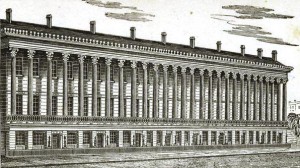A Little Piece of London, France, and Greece Once Stood in NoHo
726-730 Broadway (aka 418-426 Lafayette Street) is a through-block loft building located in the NoHo Historic District. Not much to look at, what used to be here is infinitely more interesting and surprising than what is, and has been, for over a hundred years. In this case what used to be here was perhaps New York’s most carefully recreated piece of London, France, and Greece — all on one site.

Designed by W. Steele and Sons Co. in 1917-19, 726-730 Broadway was built for John Wanamaker as a garage, factory and warehouse for his department store, which was then located in two buildings two blocks north on Broadway. Wanamaker’s, originally based in Philadelphia, expanded to New York City in 1896, first occupying the former A.T. Stewart building on Broadway between East 9th and East 10th Streets (demolished). Wanamakers built an additional building on the block south at 756-770 Broadway, which still stands, in 1905-07.

As seen on the 1853 map above, a presbyterian church was originally located on the Broadway side of 726-730 Broadway/418-426 Lafayette Street. But if you look closely at the map, you can see that the word “Presbyterian” is crossed out and “Unitarian” is written in. According to the New York City Directory from that year, the church building came to be occupied by the Unitarian Church of the Messiah. On the Lafayette side of the site and as seen in the map, is the southern end of Colonnade row (also known as LaGrange Terrace), originally nine Greek Revival row houses built by John Jacob Astor and completed in 1833. These were named to honor the Marquis de Lafayette, the hero of the Revolutionary War who made a triumphant return visit to America in 1826 on the fiftieth anniversary of the Declaration of Independence, which spawned a new wave of adoration for the French general, as well as a wave of renamings of important American sites for him. In this case, ‘LaGrange Terrace’ took its name from Lafayette’s own country estate back in France. Lafayette Street was then a cul-de-sac called “Lafayette Place” which only ran As far south as fourth street, and with the addition of these houses became the most prestigious address in New York.
Perhaps surprisingly, they did not chose to honor Lafayette with a row of houses designed in a French style, but rather Greek — or Greek Revival, to be exact. Why this national switcheroo? Well for one the Greek Revival style was newly fashionable at the time. And for another, Greece, the birthplace of democracy, had just fought its own successful war for independence against the Ottoman Empire, and thus in America the Greek Revival style was considered a way of honoring our shared democratic heritage, and therefore also an appropriate way to honor Lafayette for his role in making the American Revolution a success.

During the 1860s, Church of the Messiah left the building on the Broadway half of the present-day site, and A.T. Stewart, who owned the land, repurposed the structure as his Globe Theatre. Sadly, in December of 1884, the building was lost to a fire and replaced by Harrigan and Hart’s Theatre Comique.

Shortly thereafter, an enterprising group of businessmen had new plans for the site quite different from its ecclesiastical and theatrical roots. Forming a company called ‘The Old London Street Company,’ they leased the property and built a copy of Bishop’s Gate London (which they called, appropriately enough “Old London”), complete with medieval-inspired streets, shops, houses, a tavern/inn, and a church. Housed within a single structure, two “streets,” High Street and Elbow Lane, divided the space. As The New York Times reported, “Everywhere the visitor turns he is confronted by the counterpart of some historic building of old London. Near the entrance is the ‘Old Queen’s Head,’ that noted hostelry of Islington where Sir Walter Raleigh was accustomed to sit and puff the pipe that caused his servant to deluge him with water.” The architect hired for this Diagon Alley (for you Harry Potter fans)/Walt Disney World venture was Clarence W. Smith with consultation by British architect George H. Birch.


Old London Street opened on February 26, 1887, complete with costumed greeters welcoming visitors. It was open from 10:00 am to 10:00 pm, and adults were charged 50 cents while children could gain entrance for 25 cents. In spite of a vigorous advertising campaign, however, the venture closed after only a few months. After that, “Old London” was occupied by a museum of curiosities and oddities, a clothing company, and an athletic club. In November of 1903, John Wanamaker purchased the A.T. Stewart property at 726-730 Broadway, much as he did Stewart’s property just to the north around 8th Street, but did not develop it for another 13 years.
When he did, he also bought up and included in his development five of the row houses on Lafayette Street that were part of LaGrange Terrace. All were demolished to make way for the building that we have today fronting both Broadway and Lafayette Street, and thus a little piece of London, France, and Greece disappeared from our streets forever.

